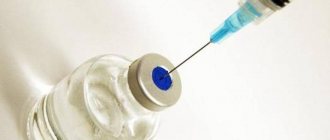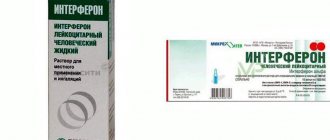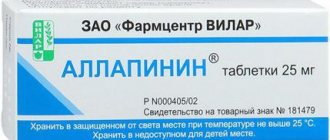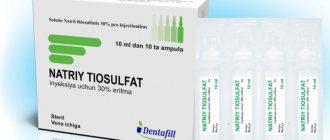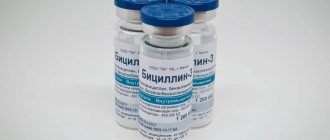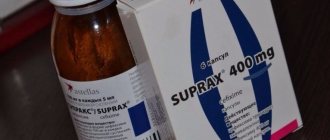Pharmacodynamics and pharmacokinetics
Sodium thiopental acts as a hypnotic and narcotic . It is used primarily for intravenous anesthesia . The drug also has some muscle relaxant and analgesic effects.
On the postsynaptic membrane of brain neurons, the drug prolongs the period of opening of γ-aminobutyric acid-dependent channels . It inhibits the excitatory effect of amino acids , prevents the conduction and spread of convulsive impulses throughout the brain, has anticonvulsant activity, and increases the threshold of neuronal excitability .
The drug promotes muscle relaxation by blocking polysynaptic reflexes and inhibiting conduction along interneurons of the spinal cord. In addition, the drug reduces metabolic processes in the brain and the brain's utilization of oxygen and glucose.
Acts as hypnotic , helps change the structure of sleep and speeds up falling asleep. Reduces the sensitivity of the respiratory center to carbon dioxide and depresses breathing. Sodium thiopental acts as cardiodepressant : it reduces stroke volume , blood pressure and cardiac output . The medicine increases the capacity of the venous system , the glomerular filtration and reduces hepatic blood flow .
Has a stimulating effect on the vagus nerve . May provoke laryngospasm and mucus production.
The effect of the drug becomes noticeable 40 seconds after intravenous administration , and after rectal administration - after 8-10 minutes. The effect of the drug is short-lived. After a single injection, anesthesia lasts 20-25 minutes. Awakening occurs without residual drowsiness .
With general anesthesia , there is a decrease or complete disappearance of tendon and corneal reflexes , a stationary or “floating” position of the eyeballs, a decrease in the depth of breathing, relaxation of the pharyngeal muscles, retraction of the tongue, and a decrease in blood pressure .
The analgesic effect ceases when the patient awakens. In case of repeated administration, the effect of the drug is prolonged.
When administered intravenously, the drug quickly reaches the brain, kidneys, adipose tissue, skeletal muscle and liver. The degree of binding to plasma is about 83%. The drug is able to penetrate the placental barrier and enter breast milk. It is broken down primarily in the liver. In this case, inactive metabolites . Some of it is inactivated in the brain and kidneys. The half-life of this drug is approximately 11 hours. Excreted mainly through the kidneys.
Briefly about the drug
Before purchasing the drug, you will need to get a prescription for “Sodium Thiopental” in Latin from your doctor. This drug has a strong narcotic effect, so it cannot be purchased without a doctor’s prescription.
What is the medicine? On the pharmacological market it is sold in the form of a light hygroscopic powder, from which a solution for intravenous administration can be prepared. The powder, one or half a gram, is packaged in glass bottles with a capacity of ten or twenty milliliters.
Indications for use
The drug is used intravenously for anesthesia during short-term operations. In addition, among its indications are: status epilepticus , grand mal seizures, increased intracranial pressure . It is also used to prevent hypoxia during TBI and as an introductory and basic anesthesia in the case of balanced anesthesia with the use of muscle relaxants and analgesics .
Reviews of “Sodium Thiopental”
Many people agree that this remedy is indeed effective and efficient, especially when it comes to anesthesia during surgery. The drug caused virtually no side effects and was tolerated relatively easily even by children.
However, there are cases when the use of the drug caused severe side effects and negative reactions of the body to the administration of anesthesia. It is difficult to find out what this was due to: the negligence of doctors, the individual sensitivity of the patient, or the negative characteristics of the anesthetic itself.
Be that as it may, this drug should be used only for medical purposes and only in specialized medical intensive care institutions.
Contraindications
This drug should not be used in case of hypersensitivity to its components, status asthmaticus , disorders of myocardial contractile function , shock and collaptoid conditions , myxedema , fever , porphyria , bronchial asthma , / kidney dysfunction , severe anemia , myasthenia , diabetes mellitus , severe exhaustion, collapse , Addison's disease , inflammatory diseases of the nasopharynx and pregnancy .
Side effects
The medicine may cause chills , arrhythmia , difficulty or complete stoppage of breathing, nausea, rectal irritation, drowsiness , rectal bleeding hypotension , laryngospasm , bronchospasm , vomiting, headache and heart failure . In addition, when using it, the following allergic reactions : urticaria , itching , skin rashes, anaphylactic shock .
Negative reactions to medication
Before using this drug as anesthesia, the attending physician will familiarize the patient with possible negative manifestations that may arise from the use of sodium thiopental.
First of all, we are talking about dizziness and lethargy, as well as memory impairment. These symptoms are most often observed in the postoperative period after the use of anesthesia. This is due to dose-dependent depression of the central nervous system. What do patients say about the use of sodium thiopental? In reviews of this drug, people note that they have encountered such unpleasant phenomena as seizures, muscle twitching, drowsiness and anxiety. Quite rarely, patients were bothered by such negative reactions to anesthesia as hallucinations, back pain, confusion, and so on.
Also, according to patient reviews, after using the drug they were worried about interruptions in heart rhythm, low blood pressure, and collapse.
The respiratory system may react negatively to the use of anesthesia with bronchospasms, difficulty breathing, sneezing or coughing.
After using the medication, a person may experience abdominal pain, nausea, and vomiting.
Among other unpleasant symptoms, patients note skin rashes, hives, redness of the epidermis, and hiccups.
Directly upon administration of the drug, a person may experience pain or burning at the injection site, redness of the skin in the injection area, peeling, and vascular spasms.
How should an anesthetic be used to minimize the number and severity of the symptoms mentioned above?
Instructions for use of Sodium Thiopental (Method and dosage)
The medicine should be injected into the vein slowly. Speed approximately 1 ml/min. Otherwise, the likelihood of collapse .
Instructions for use of Thiopental Sodium indicate that, as a rule, a 2-2.5% solution of the drug is used anesthesia Children, elderly patients and weakened patients are administered a 1% solution. It is prepared immediately before use using pure water for injection , otherwise after a few hours the medicine will no longer be suitable for administration.
To prepare a 5% solution, add 20 ml of water for injection . A 1.25% solution is prepared by dissolving 0.5 g of Sodium Thiopental in 40 ml of water. The solvent used is purified water, 5% glucose solution or physiological sodium chloride solution. The solvent is drawn into a syringe and poured into an ampoule with the drug, where everything is mixed until the medicine is completely dissolved. The finished solution must be completely transparent, otherwise it cannot be used.
For induction of anesthesia, 20-30 ml of a 2% solution is injected. The same dosage is administered when using Sodium Thiopental alone for minor short-term operations. As a rule, 2-3 ml of solution is first injected , and then the remaining amount is injected after 20-30 seconds.
A 5% solution is slowly injected in a dosage of 4-6 ml into the cubital vein . If sleep does not occur, is injected . In most cases, no more than 10-12 ml of the drug is needed anesthesia The dosage is adjusted depending on the effect of the drug.
To relieve seizures, the drug is administered intravenously at a dose of 75-125 mg for 10 minutes. If seizures develop in the case of local anesthesia , administration of 125-250 mg for 10 minutes is indicated.
In case of hypoxia , the drug is administered at a dosage of 1.5-3.5 mg/kg 60 seconds before temporary cessation of blood circulation.
Patients with renal dysfunction are prescribed 75% of the average dosage.
For children, the drug can be administered rectally . For this, a 5% solution is used. Dosage – 0.04-0.05 g per 1 year of the patient’s life (age from 3 to 7 years).
In children, the medicine is administered intravenously Dose – 3-5 mg/kg. Before inhalation anesthesia without previous premedication the following dosages are indicated:
- 1-12 years – 5-6 mg/kg is administered;
- 1-12 months – 5-8 mg/kg is administered;
- up to 1 month – 3-4 mg/kg is administered.
For general anesthesia, children weighing 30-50 kg are administered 4-5 mg/kg. Maintenance dosage is from 25 to 50 mg.
A single dosage for adult patients should not exceed 1 g.
In order to avoid respiratory depression, it is advisable to give the patient to breathe a mixture of oxygen and carbon dioxide during anesthesia . In case of respiratory and circulatory disorders, administration of Cordiamin , caffeine, Corazol intravenously or intramuscularly .
special instructions
Use only in a specialized department by anesthesiologists and resuscitators, with the availability of means to maintain cardiac activity and ensure airway patency, and artificial ventilation. It should be taken into account that achieving and maintaining general anesthesia of the required depth and duration depends on both the amount of the drug and the individual sensitivity of the patient to it. For inflammatory diseases of the upper respiratory tract, it is indicated to ensure patency of the upper respiratory tract, up to tracheal intubation. Unintentional intra-arterial administration causes immediate vascular spasm, accompanied by circulatory disturbances distal to the injection site (thrombosis of the main vessel with subsequent development of necrosis and gangrene is possible). The first sign of it in conscious patients: complaints of a burning sensation spreading along the artery; in patients under general anesthesia, the first symptoms are transient pallor, patchy cyanosis or dark coloration of the skin. Treatment: stop administration; inject a heparin solution intra-arterially into the lesion site, followed by anticoagulant therapy; glucocorticosteroid solution followed by systemic therapy; carry out a sympathetic blockade or blockade of the brachial nerve plexus (intra-arterial administration of the rolled product). In case of chemical irritation of tissues (associated with a high pH value of the solution (10-11), if the solution gets under the skin, in order to quickly resolve the infiltrate, a local anesthetic is administered and warming is carried out (activation local blood circulation). A sign of extravasation is subcutaneous swelling. In the case of intravenous jet administration to children under 18 years of age, careful monitoring of the patient’s condition is necessary in order to promptly identify symptoms of respiratory depression, hemolysis, decreased blood pressure, extravasation. The anesthetic effect is unreliable in persons who abuse alcohol. It should reduce the dose in patients taking digoxin, diuretics; in patients who received morphine as premedication, as well as after administration of atropine, diazepam. Premedication - with any of the generally accepted drugs, with the exception of phenothiazine derivatives. With prolonged anesthesia, when the hypnotic effect caused by thiopental sodium is supported by intravenous use of long-acting anesthetics and/or inhalational anesthetics; due to the danger of a cumulative effect, the dose of sodium thiopental should not exceed 1 g. It can be used in combination with muscle relaxants, subject to artificial ventilation. Sodium thiopental does not affect the tone of the pregnant uterus. After intravenous administration, the maximum concentration in the umbilical cord is observed after 2-3 minutes. The maximum permissible dose is 250 mg. When used in obstetric and gynecological surgery, it can cause CNS depression in newborns.
Overdose
In some US states, an overdose of Sodium Thiopental is used for execution.
Currently, the following symptoms of overdose with this drug are known: depression of the nervous system, muscle hyperreactivity , laryngospasm , decreased blood pressure , decreased total peripheral vascular resistance , post-anesthesia delirium , convulsions, depression of the respiratory center, water-electrolyte disturbances, tachycardia . The use of this drug in doses significantly higher than normal leads to edema , cardiac arrest and circulatory collapse .
The antidote is Bemegrid . In case of collapse and a significant decrease in pressure plasma-substituting solutions , the use of drugs with a positive inotropic effect and/or vasopressor are prescribed . In case of respiratory arrest, artificial ventilation , 100% oxygen is indicated. In case of laryngospasm, the patient is given muscle relaxants and 100% oxygen under pressure. For convulsions, intravenous administration of Diazepam . If this does not help, use mechanical ventilation and muscle relaxants .
Interaction
The administration of Sodium Thiopental for anesthesia is usually combined with the use of muscle relaxants . This drug is contraindicated to be mixed with Ditiline , Diprazine , Pentamin , Aminazine .
Interaction with ethanol and drugs that depress the nervous system causes a mutual enhancement of the effects of the drugs. Thus, this can provoke significant depression of the central nervous system, increased hypotensive effect, difficulty breathing and increased hypnotic effects.
When combined with Magnesium Sulfate, CNS depression increases. The hypotensive effect is enhanced by interaction with antihypertensive drugs. Concomitant use with Methotrexate increases its toxic effect.
Thiopental Sodium reduces the effect of indirect anticoagulants , contraceptives , Griseofulvin , GCS . It also increases the effects of medications that cause hypothermia .
Combination with Ketamine in blood pressure and depression of the respiratory center more likely It also leads to a prolongation of the recovery time of body functions after the body recovers from general anesthesia .
The effect of Sodium Thiopental is enhanced by drugs that inhibit tubular secretion and H1-histamine blockers . And some antidepressants , Aminophylline and analeptics , on the contrary, weaken it.
Interaction with Diazoxide increases the likelihood of a pronounced decrease in blood pressure .
The drug is not combined with antibiotics , narcotic analgesics , Epinephrine , Dipyridamole , Ketamine , Scopolamine , Ephedrine , Ascorbic acid , Chlorpromazine , Atropine , Tubocurarine chloride (cannot be mixed in one syringe).
